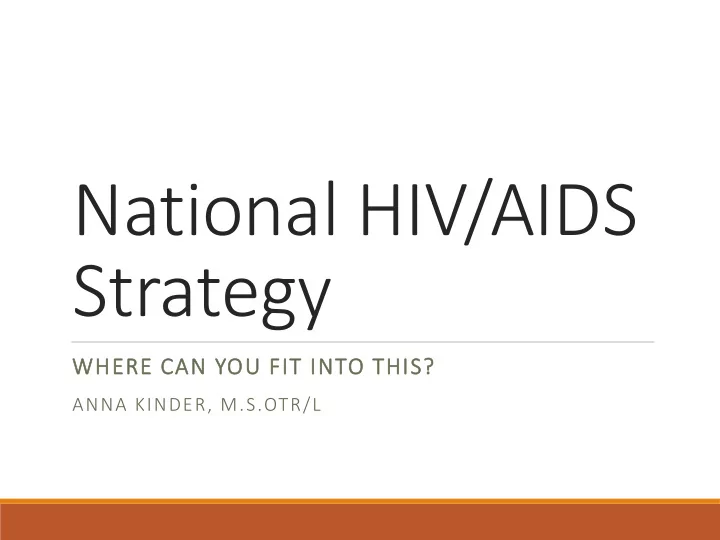

National HIV/AIDS Strategy WHERE CAN Y AN YOU F FIT I T INT NTO T THIS? S? ANNA KINDER, M.S.OTR/L
Definition THE NATIONAL HIV/AIDS STRATEGY IS A FIVE-YEAR PLAN THAT DETAILS PRINCIPLES, PRIORITIES, AND ACTIONS TO GUIDE OUR COLLECTIVE NATIONAL RESPONSE TO THE HIV EPIDEMIC .
Continuum of HIV Care - U.S. 2012 100% 100% 90 % 90 85% 85% 85% 85% 80% 80% 85% 87% 87% 81% 81% 39% 39% 36% 36% 30% 30% VL
National HIV/AIDS Strategy First came out in 2010, now goals for 2020 - There is still an HIV epidemic and it remains a major health issue for the United States - Most people can live long, healthy lives with HIV if they are diagnosed and get treatment - For a variety of reasons, certain populations bear a disproportionate burden of HIV - People across the Nation deserve access to tools and education to prevent HIV transmission - Every person diagnosed with HIV deserves immediate access to treatment and care that is non-stigmatizing, competent, and responsive to the needs of the diverse populations impacted by HIV
Advances in Four Key areas HIV prevention, care and research are still priorities - Widespread testing and linkage to care, enabling people living with HIV access to treatment early - Broad support for people living with HIV to remain engaged in comprehensive care, including support for treatment adherence. - Universal viral suppression among people living with HIV - Full access to comprehensive PrEP services for those whom it is appropriate and desired, with support for medication adherence for those using PrEP.
PrEP In 2012, FDA approved Truvada for use as PrEP. When taken consistently- PrEP can reduce one’s risk for acquiring HIV by up to 92%. Wyoming ID Webinar: PrEP Webinar January 21, 2015 12:00-1:00
HIV Testing HIV Testing- seen the development of new HIV diagnostic tests and expanded testing efforts. Screening all persons aged 15-65 years for HIV is now a GRADE A Recommendation.
Goal 1: Reducing New HIV Infections (by at least 25 percent) Focus on: MSM of all races and ethnicities Black Women and men Latino Men and women People who inject drugs Youth aged 13-24 People in Southern United States Transgender women
Goal 2: Increasing Access to Care and Improving Health Outcomes for People living with HIV Use of the care continuum Strategies to reach further, go further However- concerned with “doing the right things in the right places”
VIRAL SUPPRESSION BY STATE RSR 2013
Goal 3: Reducing HIV-Related Disparities and Health Inequities Need to reduce disparities Look at communities and societal levels Stigma and discrimination must be eliminated.
Goal 4: Achieving a More Coordinated National Response to the HIV Epidemic Everyone needs to work together.
Indicators of Progress Indicator 1: Increase the percentage of people living with HIV who know their serostatus to at least 90%. ( 1 in 8 don’t know) Indicator 2: Reduce the number of new diagnoses by at least 25 percent. Indicator 3: Reduce the percentage of young gay and bisexual men who have engage in HIV-risk behaviors by at least 10%.
Indicators 4-5 Indicator 4: Increase the percentage of newly diagnosed persons linked to HIV medical care within one month of their HIV diagnosis to at least 85 percent. (In 2013, 82 percent newly diagnosed linked within 3 months) Indicator 5: Increase the percentage of persons with diagnosed HIV infection who are retained in HIV medical care to at least 90 percent. (In 2012- only 39 percent were engaged in care)
Indicators 6-8 Indicator 6: Increase the percentage of persons with diagnosed HIV infection who are virally suppressed to at least 80 percent. (in 2012- only 30 percent achieved viral suppression Indicator 7: Reduce the percentage of persons in HIV medical care who are homeless to no more than 5%. Indicator 8: Reduce the death rate among persons with diagnosed HIV infection by at least 33%
Indicators 9-10 Indicator 9: Reduce disparities in the rate of new diagnosis by at least 15 percent in the following groups: gay and bisexual men, young Black gay and bisexual men, Black females, and persons living in the Southern United States. Indicator 10: Increase the percentage of youth and persons who inject drugs with diagnosed HIV infection who are virally suppressed to at least 80 percent.
T HE F UTURE OF AIDS E DUCATION & T RAINING IN THE N EW F RONTIER
HRSA Program Changes Three workforce development priorities: • Clinical care • Interprofessional teams (e.g., IPE Project) • Organization and systems management (e.g., PT Project)
Frontier AETC Region 22
HIV National Curriculum (with NCRC) UW Leadership Team David Spach Andrew Karpenko Kent Unruh Natalia Martinez-Paz
HIV National Curriculum (with NCRC)
Triple AIM + Triple Aim Better Care
What does it mean to us? • Work with clinic leadership: Improve Care Continuum Outcomes • HIV Screening • Linkages to Care • Retention in Care • Suppression of Viral Load • Build capacity: High-quality comprehensive care and treatment • Develop accountable care communities and interprofessional teams
Participation Criteria Clinics with: ◦ low volume HIV providers who can improve quality care and access ◦ FQHC designation and/or RW Part A/B ◦≥ 30% racial/ethnic patient diversity ◦ Minority staff & providers ◦ Willingness to participate in long term project
Recommend
More recommend